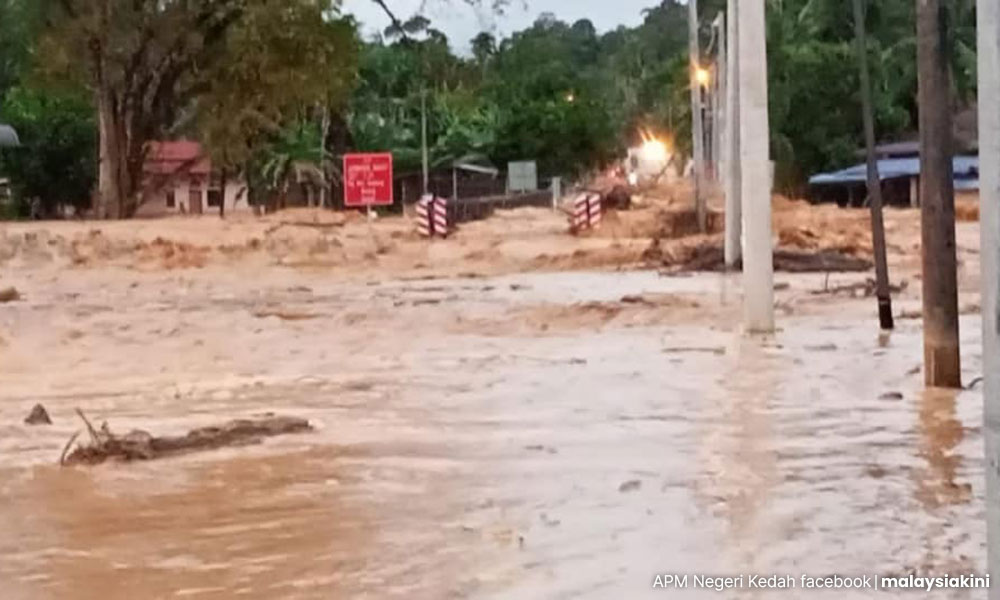Faced with a third round of flooding in two months, residents of Kampung Iboi near Baling are now asking how much longer they need to live in fear each time it rains.
The villagers say they have been in such a state since mud floods killed three people and displaced more than a thousand residents on July 4.
Their constant trepidation became reality at 5.30pm yesterday, when water came gushing down Gunung Inas to flood the village again after a 30-minute heavy downpour, forcing more than 100 residents to evacuate.
Villagers, particularly elderly residents who are on their own at home when their children are at work, said they constantly worry for their safety and no longer have peace of mind.
The temporarily built Bailey Bridge, built after the original bridge was washed away on July 4, got submerged yesterday.
Pertubuhan Kebajikan Amal Iboi chairperson Syuhaimi Zakaria said the bridge was submerged as it was only two feet above the surface of Sungai Kupang.
"Gushing water from the hills that came down with the debris caused the electricity poles and the bridge to become tilted, waiting to be swept away if there is another downfall later," he said.
Syuhaimi said the latest flooding came just 62 days after the fatal incident in July, and six days after Prime Minister Ismail Sabri Yaakob visited the disaster area.
"The houses of previous flood victims were once again flooded with mud and wooden debris. The Temporary Transfer Centre is back in operation again," he said.
Aid provided after earlier flood destroyed
The group deputy chairperson Ahmad Shukri Mat Piah said the villagers are facing more damage, on top of recurring trauma.
"All the aid and equipment that was recently given by the government and NGOs were destroyed. Crops were damaged and destroyed, with our livestock drowning in the floods yesterday.
"The question is, until when do we have to endure this torture and suffering? We earnestly urge and plead for the state and federal authorities to take swift action.
"This flood has happened three times but there is still no clear action taken to reduce the risk of ongoing disasters," he said.
Shukri said only the soil which piled up on the ground after July 4 has been moved, but the sand that settled at the bottom of the river is still there.
"Remaining debris is still being cleaned and returned to our homes. Each (authority) is just busy blaming the other, and the population is left defenceless," he said.
On that note, Shukri urged for the recommendations in the Geological Disaster Study Report to be acted upon immediately.

Among the short-term measures recommended was to evacuate residents living within established danger zones, as more floods are expected in the next few months because the river has become up to two metres shallower from the flow of debris.
"Don't just force us residents and flood victims to accept the results of the study while the government is not implementing the recommended actions made by the experts involved.
"All the ridges and water reservoirs on the top of the mountain must be drained out immediately," he said.
Villagers want an RCI
Shukri added that the villagers urged the government to set up a royal commission of inquiry (RCI) to investigate the cause of this disaster and bring the guilty to justice.
"What was the reading of the automatic rain gauge at the top of Gunung Inas? How loud is the flood warning sirens?
"How many times have dialogues and explanations about this flooding been carried out with villages? How much of the Kupang river sediment have been dredged and dumped?" he asked.
Shukri also called upon the government to put an end to the Musang King durian plantation, which the Geological Disaster Study Report said exacerbated erosion due to heavy rain.

"Our lives are at stake every time there is a flood," he said.
The Geological Disaster Study Report concluded that the disaster, estimated to cost RM25.91 million in losses, was mainly caused by land erosion and the movement of debris in the highland, which triggered debris to flow into Sungai Kupang.
The secondary cause, it added, was the land clearing of 5,000 hectares in Compartment 8 of the forest reserve, of which 823 hectares were planted with rubber and durian trees.
"The changes in land used exacerbated the rate of erosion. Piles of material from previous erosion combined with new erosion during heavy rainfall on July 4 also contributed to the increase in debris which was picked up by the flow, leading to the flood," the report stated. - Mkini




No comments:
Post a Comment
Note: Only a member of this blog may post a comment.